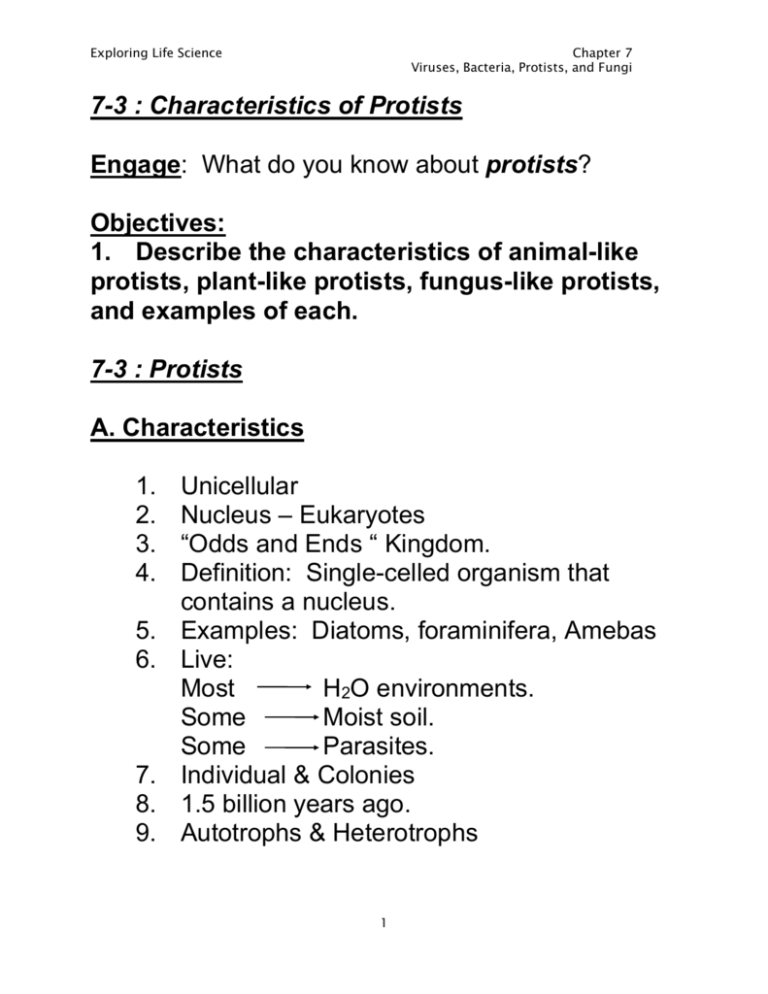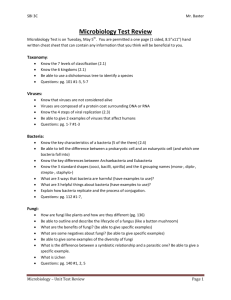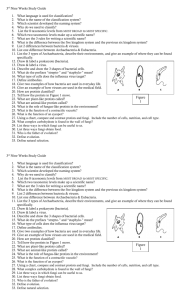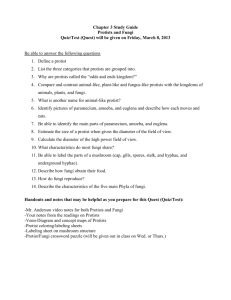Notes 7-3
advertisement

Exploring Life Science Chapter 7 Viruses, Bacteria, Protists, and Fungi 7-3 : Characteristics of Protists Engage: What do you know about protists? Objectives: 1. Describe the characteristics of animal-like protists, plant-like protists, fungus-like protists, and examples of each. 7-3 : Protists A. Characteristics 1. 2. 3. 4. 5. 6. 7. 8. 9. Unicellular Nucleus – Eukaryotes “Odds and Ends “ Kingdom. Definition: Single-celled organism that contains a nucleus. Examples: Diatoms, foraminifera, Amebas Live: Most H2O environments. Some Moist soil. Some Parasites. Individual & Colonies 1.5 billion years ago. Autotrophs & Heterotrophs 1 Exploring Life Science Chapter 7 Viruses, Bacteria, Protists, and Fungi 10. Animal-like Protists Plant-like Protists Fungus-like Protists B. Animal-like Protists 1. Protozoan -- “first animals” a. Nucleus b. No cell wall like c. Heterotroph animals d. Move 2. 4 Main Groups a. Sarcodines b. Ciliates c. Zoo Flagellates d. Sporozoans C. Sarcodines 1. Sarcodines -- Have extensions of cell membrane and cytoplasm known as pseudopods. 2. Pseudopods -- “false foot” function Capture and engulf food 2 Exploring Life Science Chapter 7 Viruses, Bacteria, Protists, and Fungi Movement 3. Shells -- Support & Protect Example: foraminiferans -- coins Radiolarians -- look like Christmas ornaments. 4. Ameba -- “blob-like” a. Use psuedopods to move and to obtain food. 3 Exploring Life Science Chapter 7 Viruses, Bacteria, Protists, and Fungi 4 Exploring Life Science Chapter 7 Viruses, Bacteria, Protists, and Fungi b. Structure Cell Membrane -- Controls movement c. of particles -H2O, O2 , CO2 & wastes Nucleus Contractile Vacuole -- keeps the right amount of H2O in its cell. Food Vacuole – Digestion Waste elimination by vacuole joins with membrane. Cytoplasm Psuedopod -- Movement and gathering food. Reproduction -- Cell Division. Mitosis. Ameba Ameba Ameba d. Respond to stimulus -- Light, chemicals. 5 Exploring Life Science Chapter 7 Viruses, Bacteria, Protists, and Fungi D. Ciliates 1. Ciliates -- Have small hair-like projections called cilia on the outside of their cells. 2. Cilia – Act like tiny oars to move organisms Sweep food toward them Act as sensors. 3. Paramecium -- slipper-shaped. a. Structure 6 Exploring Life Science Chapter 7 Viruses, Bacteria, Protists, and Fungi Contractile Vacuole -- Controls H2O. Micronucleus -- Small - conjugation. Macronucleus -- Big - controls life function. Oral Groove -- Indentation notch on side (Mouth). Gullet -- Funnel-like (Throat). Anal Pore-- Empties waste Trichocyst--Sharp spines - protection Food Vacuole -- Digests food. Pellicle -- Cell membrane - shape. Cilia -- Hair-like projections. b. Conjugation -- 2 ciliates temporarily joined together -exchange part of their DNA. c. Reproduction -- Splitting in half crosswise. (See figure 6-11). E. Zoo Flagellates 1. Zoo Flagellates -- Move by means of flagellum. 2. Flagellum -- Long, whip-like structure that propels a cell (moves). 3. Animal-like, plant-like or fungus-like. Animal-like -- Zooflagellates. Usually 1-8 flagella. Sometimes 1000’s. 7 Exploring Life Science Chapter 7 Viruses, Bacteria, Protists, and Fungi 4. Live a. Inside organisms -- symbiotic. Example: termites -- intestines to digest wood. Parasitic Example: Humans -- African sleeping sickness -- tsetse fly. 5. Diseases Trichomonas -- Infection female reproduction system. Giardia – Parasite in humans – attach to intestines – Beavers – “Hikers disease”. E. Sporozoans 1. Sporozoans -- Parasites that feed on the cells and body fluid of their host animal. 2. Spores -- Enable sporozoans to pass from one host to another. Spore Source -- Food, tick, mosquito. 3. Malaria -- “Plasmodium” 2 hosts -- Humans & mosquito. Need both to complete the life cycle. (Results -- high fever for 6-8 hours every 48 hours for several weeks). 8 Exploring Life Science Chapter 7 Viruses, Bacteria, Protists, and Fungi Plant-like Protists A. Introduction 1. Most Unicellular 2. Algae * 3. Autotrophs a. Starts a lot of food chains b. O2 production (70%) 4. Most are flagellates -- Move with flagella. 5. Phytoflagellates phyto = plant 6. 6 Groups a. Diatoms b. Dinoflagellates c. Euglenoids d. Red Algae e. Green Algae f. Brown Algae B. Euglenoids 1. Green unicellular algae 2. Can be Heterotrophs & Autotrophs 2. Euglena a. Pouch -- holds (2) flagella. b. Eyespot -- red -- sensitive to light. Why important? 9 Exploring Life Science c. Chapter 7 Viruses, Bacteria, Protists, and Fungi Chloroplasts/grass-green structures for food making. C. Diatoms 1. In toothpaste 2. 10,000 species 3. Water-dwelling 4. Beautiful glasslike cell walls 5. Die – cell walls remain -- form deposits (diatomaceous earth) polishing agent -- scouring cleansers 10 Exploring Life Science Chapter 7 Viruses, Bacteria, Protists, and Fungi D. Dinoflagellates - unicellular algae 1. Red Tides -- Dinoflagellates reproduce so rapidly that the water becomes colored by them (yellow-green) to (orange-brown). Dangerous -- Produce toxins that can injure or kill living things. 2. Glow at night 3. Elaborate armored cell walls 4. Spin like a top - caused by 2 flagella E. Red Algae 1. Multicellular seaweed 2. Several meters long -- not as big as brown algae. 3. Attached to rocks on the ocean floor. 4. 260m 5. Accessory pigments able to absorb small amount of light transfer chlorophyll 6. Uses a. Food – Asian cultures b. Fertilizer c. Chemicals -- Manufacture certain foods (ice cream) “Carrageenan” & “Agar” 11 Exploring Life Science Chapter 7 Viruses, Bacteria, Protists, and Fungi F. Green Algae 1. Most unicellular 2. Fresh & Salt water or moist areas on land. 3. Green algae evolved into land plants. G. Brown Algae 1. Seaweed 2. Sargassum -- Brown algae floats on the ocean’s surface -- air bladders keep them afloat. “Sargasso Sea” Home for many organisms. 3. Giant Kelp – Attach to sea floor. 4. Rockweed – Atlantic coast 5. Food -- People & livestock. 6. Chemicals from Brown Algae. Algins or Alginates -- added to salad dressing & other foods. Make them smooth & prevent their ingredients from separating. 12 Exploring Life Science Chapter 7 Viruses, Bacteria, Protists, and Fungi Fungus-like Protists 1. Characteristics a. Fungi – “sort of like” kingdom b. Heterotrophs c. Cell wall d. Spores – for reproduction 2. 3 types Slime Mold a. Life cycle -- moist, flat, shapeless blobs that ooze slowly over dead trees . . . “slime” 13 Exploring Life Science Chapter 7 Viruses, Bacteria, Protists, and Fungi Water Molds & Downy Mildews a. Live in water or moist places. b. Great Potato Famine in Ireland 1845-1846 (killed 1,000,000 people) c. Can attack -- potatoes, cabbages, corn and grapes. d. Animals -- get diseases (i.e., white spots of fins & mouth of aquarium fish). 14 Exploring Life Science Chapter 7 Viruses, Bacteria, Protists, and Fungi 15 Exploring Life Science Chapter 7 Viruses, Bacteria, Protists, and Fungi 16









